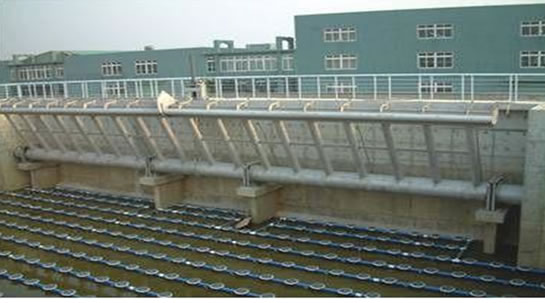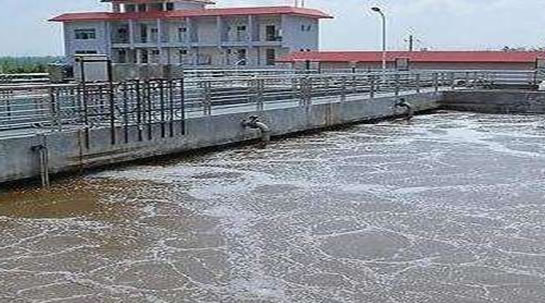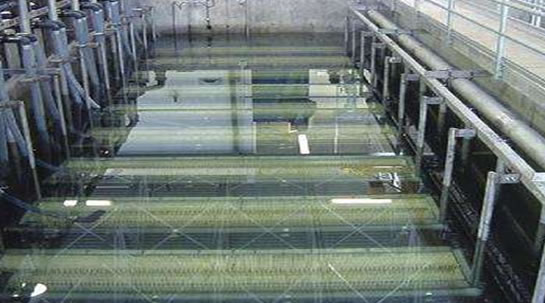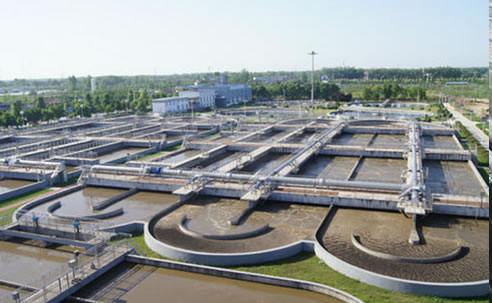1. Process introduction
Sequencing Batch Activated Sludge Process-SBR for short, is different from traditional sewage treatment processes. SBR technology uses time division operation instead of space division operation, and non-stable biochemical reaction instead of steady-state biochemical reaction , Let stand ideal precipitation instead of traditional dynamic precipitation. Its core is the SBR reaction tank, which integrates the functions of homogenization, primary sedimentation, biodegradation, and secondary sedimentation into one tank. The process flow is:
Between coarse and fine grids—regulating tank—pretreatment tank—SBR tank—advanced treatment—disinfection—discharge
2. Main equipment
The process facility of SBR tank is composed of aeration device (blower, aerator), supernatant discharge device (decanter) and other auxiliary equipment.
3. Process advantages
(1) The process is simple. One SBR reactor replaces the anaerobic tank, aeration tank, secondary settling tank and sludge return system in the ordinary activated sludge process, thus greatly saving the area of the treatment system structure;
(2) Impact load resistance, good denitrification and phosphorus removal effect;
(3) It can fully inhibit sludge expansion;
(4) Flexible operation and easy to realize high automation.
Fourth, the scope of application
In addition to the application of the SBR process in urban small and medium-sized sewage treatment plants, it has also been gradually applied to the treatment of industrial wastewater such as monosodium glutamate, beer, pharmaceuticals, papermaking, printing and dyeing, washing, and slaughter, and has achieved good results.

AAO sewage treatment process
1. Process introduction
AAO method, also known as A2O method, is the abbreviation of the first letter of English Anaerobic-Anoxic-Oxic (Anaerobic-Anoxic-Aerobic). It is a commonly used sewage treatment process and has good nitrogen and phosphorus removal effects. Sewage through anaerobic-anoxia-aerobic alternate reaction, and under the action of nitrification liquid return and sludge return, the organic matter can be degraded and COD, BOD, N and P are simultaneously removed. The process flow is:
Between coarse and fine grids—regulating tank—pretreatment tank—anaerobic tank—anaerobic tank—aerobic tank—secondary sedimentation tank—advanced treatment—disinfection—discharge
2. Main equipment
A2O biochemical tank process facilities are mainly composed of agitating device (submersible agitator), aeration device (blower, aerator), return device (sewage pump) and other auxiliary equipment.
3. Process advantages
(1) This process can be called the simplest simultaneous nitrogen and phosphorus removal process in the system, and the total hydraulic retention time is less than other types of processes;
(2) Under anaerobic, anoxic, and aerobic alternate operation conditions, filamentous bacteria cannot proliferate in a large amount, and sludge filamentary expansion is not easy to occur, and the SVI value is generally less than 100;
(3) Mature technology, low cost per ton of water treatment, and a wide range of applications;
(4) There are many improved processes based on the A2O process (such as inverted A2O, multi-level AO, etc.), and suitable processes can be selected according to the sewage quality.
Fourth, the scope of application
The A2O process and the improved A2O process are widely used in large, medium and small urban sewage treatment plants, and industrial sewage treatment with low concentrations of various pollutants.

MBR sewage treatment process
1. Process introduction
MBR is also known as Membrane Bio-Reactor. By organically combining membrane separation technology in separation engineering with traditional wastewater biological treatment technology, it not only eliminates the need for the construction of secondary sedimentation tanks, but also greatly improves the efficiency of solid-liquid separation. And because of the increase in the mass concentration of activated sludge in the aeration tank and the emergence of special bacteria in the sludge, the biochemical reaction rate is increased. At the same time, by reducing the F/M ratio to reduce the amount of surplus sludge (or even zero), it basically solves many outstanding problems in the traditional activated sludge process. The process flow is:
Between coarse and fine grids—regulating tank—pretreatment tank—MBR reaction tank—disinfection—discharge
2. Main equipment
The MBR reaction tank process facilities are mainly composed of aeration devices (blowers, aerators), membrane bioreactors (MBR membranes, effluent self-priming pumps, etc.), backwashing devices (backwashing pumps) and other auxiliary equipment.
3. Process advantages
(1) Due to the efficient separation effect of the membrane, the separation effect is much better than that of the traditional sedimentation tank, the treated effluent is extremely clear, and the suspended matter and turbidity are close to zero;
(2) The process can be operated under high volume load and low sludge load, and the remaining sludge output is low;
(3) The internal load of the reaction tank is high, the system processing efficiency is high, and the floor space is greatly saved;
(4) The hydraulic retention time (HRT) and the sludge retention time (SRT) are completely separated, and the operation control is more flexible and stable;
(5) It is easy to upgrade and transform from traditional technology.
Fourth, the scope of application
The MBR treatment process is mainly used for sewage treatment in small and medium-sized cities or upgrading and transformation of old sewage plants, decentralized village sewage treatment, and industrial sewage treatment with high concentrations of various pollutants.

Oxidation ditch sewage treatment process
1. Process introduction
The oxidation ditch uses a Continuous Loop Reactor (CLR) as a biological reaction tank, and the mixed liquid is continuously circulated in a closed aeration channel in the reaction tank, usually under delayed aeration conditions. The oxidation ditch uses an aeration and agitation device with direction control to transfer the horizontal velocity to the substance in the reaction tank, so that the agitated liquid circulates in the closed channel. The process flow is:
Between coarse and fine grids-degreasing tank-oxidation ditch-secondary settling tank-advanced treatment-disinfection-discharge
2. Main equipment
The process facilities in the oxidation ditch are mainly composed of aeration devices (aeration turntables, jet aerators, etc.), stirring devices (submersible thrusters, submersible mixers, etc.), reflux devices (reflux pumps) and other auxiliary equipment.
3. Process advantages
(1) The circulating flow is large, so that the influent can be mixed and diluted quickly, and it has strong shock load resistance;
(2) Simplified pretreatment and sludge treatment, short process flow, few structures and equipment, no primary sedimentation tank, adjustment tank, and convenient control and management;
(3) Low cost, fast construction, low equipment accident rate, and less operation management workload;
Fourth, the scope of application
The oxidation ditch treatment process is mainly used in large, medium and small urban sewage
